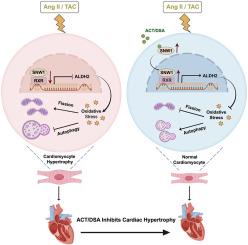Antrodia cinnamomea triterpenoids attenuate cardiac hypertrophy via the SNW1/RXR/ALDH2 axis
IF 10.7
1区 生物学
Q1 BIOCHEMISTRY & MOLECULAR BIOLOGY
引用次数: 0
Abstract
Aldehyde dehydrogenase 2 (ALDH2), a pivotal enzyme in the metabolism of toxic aldehydes produced by oxidative stress, has been demonstrated to play a cardioprotective role in cardiovascular diseases. Antrodia cinnamomea triterpenoids (ACT) is a medicinal mushroom with anti-inflammatory and antioxidant properties, and our previous study found that ACT can exert anti-fatty liver effects by regulating ALDH2. This study aimed to elucidate the impact of ACT and its monomer on cardiac hypertrophy and investigate the relationship between its pharmacological mechanism and ALDH2. Through examining cardiac morphology and expression levels of hypertrophic biomarkers, ACT significantly reduced myocardial hypertrophy induced by angiotensin II (Ang II) and transverse aortic constriction (TAC)surgery in wild-type mice, but not in ALDH2 knockout mice. In vitro, ACT and its monomeric dehydrosulphurenic acid (DSA) inhibited the hypertrophic phenotype of Ang II-stimulated neonatal cardiac myocytes (NRCMs) in an ALDH2-dependent manner. Regarding the pharmacological mechanism, it was observed that ACT and DSA restored ALDH2 expression and activity in myocardial tissues of WT-Ang II/TAC mice and Ang II-induced NRCMs. Furthermore, it inhibited oxidative stress and improved mitochondrial quality control (MQC) homeostasis in an ALDH2-dependent manner. We screened SNW1, a transcriptional coactivator, as a DSA-binding protein by “target fishing” and cellular enthusiasm transfer assay techniques and validated that SNW1 promoted ALDH2 transcription and translation levels through synergistic interaction with the transcription factor RXR. In conclusion, the findings demonstrate that ACT/DSA upregulates ALDH2 expression via regulating SNW1/RXR, thereby inhibiting oxidative stress and maintaining MQC homeostasis, and then protects against cardiac hypertrophy.

蚂蚁肉桂三萜类化合物通过SNW1/RXR/ALDH2轴减轻心肌肥大
醛脱氢酶2(ALDH2)是氧化应激产生的有毒醛类代谢过程中的关键酶,已被证实在心血管疾病中发挥着保护心脏的作用。杏鲍菇三萜(ACT)是一种具有抗炎和抗氧化特性的药用蘑菇,我们之前的研究发现,杏鲍菇三萜可通过调节 ALDH2 发挥抗脂肪肝的作用。本研究旨在阐明ACT及其单体对心肌肥大的影响,并探讨其药理机制与ALDH2之间的关系。通过检测心脏形态学和肥厚生物标志物的表达水平,ACT能显著减轻野生型小鼠在血管紧张素II(Ang II)和横纹主动脉缩窄(TAC)手术诱导下的心肌肥厚,但不能减轻ALDH2基因敲除小鼠的心肌肥厚。在体外,ACT 及其单体脱氢亚磺酸(DSA)以 ALDH2 依赖性方式抑制 Ang II 刺激的新生心肌细胞(NRCMs)的肥大表型。在药理机制方面,观察到 ACT 和 DSA 恢复了 WT-Ang II/TAC 小鼠和 Ang II 诱导的 NRCMs 心肌组织中 ALDH2 的表达和活性。此外,它还能以 ALDH2 依赖性方式抑制氧化应激并改善线粒体质量控制(MQC)平衡。我们通过 "钓靶 "和细胞热情转移分析技术筛选出转录辅激活因子 SNW1 作为 DSA 结合蛋白,并验证了 SNW1 通过与转录因子 RXR 的协同作用促进了 ALDH2 的转录和翻译水平。总之,研究结果表明,ACT/DSA通过调节SNW1/RXR上调ALDH2的表达,从而抑制氧化应激和维持MQC平衡,进而保护心肌不肥厚。
本文章由计算机程序翻译,如有差异,请以英文原文为准。
求助全文
约1分钟内获得全文
求助全文
来源期刊

Redox Biology
BIOCHEMISTRY & MOLECULAR BIOLOGY-
CiteScore
19.90
自引率
3.50%
发文量
318
审稿时长
25 days
期刊介绍:
Redox Biology is the official journal of the Society for Redox Biology and Medicine and the Society for Free Radical Research-Europe. It is also affiliated with the International Society for Free Radical Research (SFRRI). This journal serves as a platform for publishing pioneering research, innovative methods, and comprehensive review articles in the field of redox biology, encompassing both health and disease.
Redox Biology welcomes various forms of contributions, including research articles (short or full communications), methods, mini-reviews, and commentaries. Through its diverse range of published content, Redox Biology aims to foster advancements and insights in the understanding of redox biology and its implications.
 求助内容:
求助内容: 应助结果提醒方式:
应助结果提醒方式:


